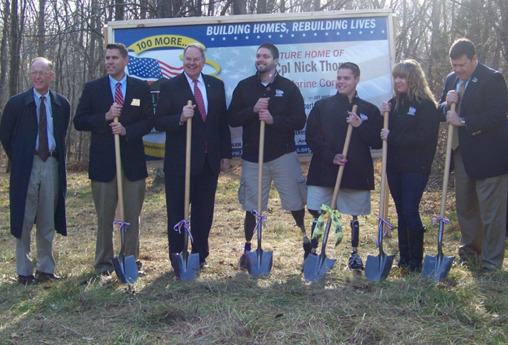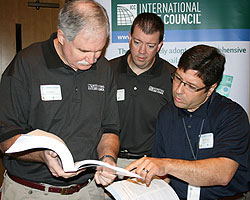
 |
| VBCOA Region V Attends Groundbreaking for Wounded Veteran Nick Thom New, specially adapted home will allow veteran the freedom and independence he fought hard to preserve. Newly elected Virginia Building and Code Officials Association (VBCOA) Region V (Northern Virginia) Chairman Charlie Black and longtime member Dick Meyer attended a ceremony on December 8 to honor Marine Lance Corporal Nicholas Thom and celebrate the groundbreaking for his new home in Broad Run, Virginia. In honor of his service and as a result of his injuries, the organization Homes for Our Troops is building a new home for Thom and his wife Samantha. The newlyweds are looking forward to moving into a specially adapted home that will allow Nick the freedom and independence he fought hard to preserve. Homes for Our Troops is a national non-profit organization committed to helping severely injured veterans and their immediate families by raising funds, building materials and professional labor to build a fully accessible home at no cost to the veterans they serve. Thom was severely injured while on a four-day, counter-insurgency mission in Afghanistan. He was left a bilateral amputee with multiple upper-extremity injuries when an improvised explosive device was detonated remotely by insurgents on April 4, 2010. He was carried out of the line of fire by fellow Marines and treated by doctors at the scene. He was evacuated to Germany and then to the Walter Reed National Medical Center, where he continues receiving treatment and therapy. During the ceremony, Chairman Black expressed his sincere gratitude and commented, "The mass of veterans, neighbors, dignitaries and friends attending the ceremony was quite impressive and memorable. It was an honor for me to be present and represent VBCOA in this endeavor. I further advised Nick and Sam that VBCOA members will be checking in on them from time to time, just as any good neighbor would." In 2010, VBCOA Secretary Sean Farrell initiated the relationship with Homes for Our Troops to offer help through the regulatory process, and possibly provide labor as needed. However, the project went through a series of delays in 2011 and 2012, during which time Public Information Committee Chair Gregg Fields along with fellow member Dick Meyer maintained constant contact with Homes for Our Troops to reiterate their commitment to the cause. The project finally overcame a series of setbacks and broke ground on December 8, 2012. |
||
 |
 |
|
Region V Chair Charlie Black (left) with Lance Corporal Nicholas Thom and his wife, Samantha, at the December groundbreaking ceremony for Homes for Our Troops. |
From left to right: Virginia Deputy Secretary of Veterans Affairs and Homeland Security James Hopper; Prince William County Board Supervisor of the Gainesville District Peter Candland; Virginia Secretary of Health and Human Resources Bill Hazel; Disabled Veteran Michael Martinez (also a recipient of a home in Purcellville, Va.); Lance Corporal Nicholas Thom; Samantha Thom; and Major General Tim McHale of Homes for Our Troops. |
|
| Back to top | ||
 |
| IECC News for ICC Members to Share with Media and Homebuilders Compliance with International Conservation Code can reap tax credits for homebuilders, savings for home owners. Note to ICC Members: To support you in attaining compliance with the International Energy Conservation Code in your jurisdiction and to advise your local homebuilders about available tax credits for building energy efficient homes, please consider sharing this news release with your area homebuilders and local media as well as posting on your website. For more information, you can contact David Karmol, ICC Vice President for Federal and External Affairs, dkarmol@iccsafe.org, 888-ICC-SAFE (422-7233), ext. 6243. The United States Congress recently passed the Job Protection and Recession Avoidance Act of 2012 (HR 8), which offers homebuilders a tax credit on newly constructed residential units that exceed the energy efficiency requirements of the 2006 International Energy Conservation Code (IECC) by 50 percent. A $2,000 tax credit is available to homebuilders who construct a home, apartment unit or multi-family dwelling as determined by RESNET or an equivalent rating or certification system. HR 8 extends credits for energy efficient new homes and energy efficient appliances and the ability to claim nonbusiness energy property tax credits for exterior windows, doors and skylights. Homes built to the 2012 IECC are expected to improve residential building energy efficiency by 30 percent more than those built under the 2006 edition, according to the U.S. Department of Energy. Many homes built to the 2012 IECC qualify for the tax credit referenced in HR 8 with current model HVAC equipment. HR 8 includes a homebuilder tax credit for new residential units built between Dec. 31, 2011, and Dec. 31, 2013. The two-year extension is available with the credit retroactive for homes built in 2012 that meet the energy-efficiency requirements of the law. For comparison purposes, the new legislation changed the baseline residence from a home meeting the 2004 IECC Supplement to a home that meets the 2006 IECC. The baseline for comparison of the HVAC, which is not included in the IECC, is 13 SEER and an HSPF of 7.7. The criteria defined in the U.S. Tax Code comparing homes built to the 2006 IECC is currently exceeded by many state model codes, according to specialty tax consulting firms. One leading firm, for example, found that a 98-unit apartment building constructed in 2007 designed to the minimum requirements of the California energy code met the qualification for tax credits for the dwelling units in the building exceeding $190,000. Section 401 of HR 8 extends the expired Existing Homes Energy Efficiency Tax Credit, which allows a tax credit for certain improvements meeting the prescriptive requirements of the 2009 IECC, with a limit of $500 over any amount previously claimed. This credit can apply to insulation, new HVAC equipment, windows and other equipment or systems that meet the prescriptive requirements in the 2009 IECC and specific requirements for HVAC efficiency. Click here to download a Word version of the news release. |
| Back to top |
| Interim Guidance for ICC Members on Community Development Block Grant Funding Since the passage of the National Flood Insurance Reform Act (HR 4348), that included language re-affirming and amending the use of "Community Development Block Grant" or "CDBG" grant funds for the purposes of building code administration, ICC has been working with the U.S. Department of Housing and Urban Development to create a guidance document, for both code officials interested in applying for grant funding, and for HUD program administrators and state coordinators, to make sure there is a uniform understanding that CDBG funding may be used for building code administration. ICC will also hold a webcast with HUD early this year to provide ICC Members with key information on how they can compete for this CDBG funding. The best way for code compliance departments to successfully apply for, and receive grant funds, is to make sure both code officials and HUD officials, are seeing the same guidance with respect to the code funding, according to ICC. As ICC continues to work out details with HUD officials, the following guidance is for Code Officials to use right now to position themselves to obtain CDBG grant funding. First, a few key facts: |
|
| More information to assist with a successful proposal—WITHIN your city or county. |
|
|
| These are a few ideas for laying the groundwork for a successful CDBG grant effort, both within your city or county, and at the level of HUD, whether your city is an "entitlement" jurisdiction, or whether it applies for funding through its state HUD office. The upcoming ICC/HUD document will fully explain the difference between the two types of jurisdictions, and how the process of CDBG grants varies for the two types of cities/counties. For now, follow the suggestions above, to be ready for the upcoming webinar and guidance publication. |
| Back to top |
Smith Retiring from Ashtabula County, Ohio, to Learn Something New
|
| Back to top |
FEMA's Ingargiola Recipient of Prestigious Emergency Manager Award John Ingargiola, Senior Engineer and Team Leader with the Federal Emergency Management Agency's (FEMA) Building Science Branch, Risk Reduction Division, was one of two recipients of the prestigious Exemplary Emergency Manager Award presented by FEMA Administrator W. Craig Fugate last month in Washington, D.C. The presentation was part of the 2012 FEMA Administrator's Awards that are the agency's highest honors. John Ingargiola, Senior Engineer and Team Leader with the Federal Emergency Management Agency's (FEMA) Building Science Branch, Risk Reduction Division, was one of two recipients of the prestigious Exemplary Emergency Manager Award presented by FEMA Administrator W. Craig Fugate last month in Washington, D.C. The presentation was part of the 2012 FEMA Administrator's Awards that are the agency's highest honors.Ingargiola is responsible for FEMA's wide-range of mitigation activities, including pre- and post-disaster building science activities, model building codes and standards, the development of technical guidance for multi-hazard mitigation projects, and coordinating with both public and private sectors partners on building science matters. He was honored by Fugate for his collaboration with the Code Council to develop a CodeMaster series on flood resistant designs for buildings, and for his ongoing participation in ICC's code development process. Also last year, the Association of State Floodplain Managers presented Ingargiola its prestigious John R. Sheaffer Award for Excellence in Floodproofing for his career-long efforts to foster nonstructural flood mitigation. Pictured left, FEMA Building Sciences Branch Senior Engineer John Ingargiola (right) discusses wind load provisions in the 2012 International Building Code with Code Council Technical Services staff members John Battles (left) and Jeff Walker (center). |
| Back to top |
Holmes Beach Building Permit Applications Flood City Hall, Break Record
As the city commission, its planner and attorney worked in December to prepare for the moratorium expected to halt new construction and substantial improvements Residential-2 district for six months, 90 applications came in for a variety of permits for 1,228 in 2012—breaking last year's record of 960 building applications, according to building clerk Susan Lonzo. Mayor Carmel Monti estimated "about 75 came in under the wire," in the two weeks before the moratorium effective date. "Last year was the most ever," said public works clerk Susan Corsi about 2011 building permits, adding that 2012 applications had surpassed 2011. Since Dec. 1, the submissions included applications for 20 pools, 11 erosion control permits, seven remodels and six new construction projects submitted by local contractors including Beach to Bay Construction, Ross Built Construction Co., Agnelli Pools and Construction, American Beauty, Wash Family Enterprise and Whitehead Construction, according to Lonzo. The vast majority of the permit applications were for R-2 zoned properties, she said. The R-2 district became the focus of a committee headed by Commissioner Jean Peelen after residents packed the city commission meetings in late 2011 to complain about the proliferation of multi-unit homes in the district and related noise, garbage and parking problems. Since then, the building department has worked to keep up with inspections while fielding record requests from residents, commissioners and candidates for election. Overdevelopment was blamed on lax interpretations of the land development code, which allowed alleged encroachments in setbacks and took in questionable affidavits and appraisals for remodeling under Federal Emergency Management Agency related rules. Source: The Islander | December 26, 2012 |
||||
| Back to top | ||||
| Sasaki Appointed to California Building Standards Commission California Governor Jerry Brown on Dec. 10 announced the appointment of Kent Sasaki, of Walnut Creek to the California Building Standards Commission. The position requires Senate confirmation and there is no compensation. Sasaki has served in multiple positions at Wiss Janney Elstner Associates Inc. since 1989, including principal, board member and engineer. He is a member of the American Society of Civil Engineers and the Structural Engineers Association of California, and has more than 23 years of experience investigating structures in the U.S. and internationally. He previously served as a member of the California Building Standards Commission from 2003 to 2006, and is past president of the San Francisco Section of the American Society of Civil Engineers. Sasaki, a Sansei, was born in Sacramento and grew up in Rocklin. He graduated from Roseville High School and attended Sierra College for two years before transferring to UC Berkeley and earning a master's degree in structural engineering. His father, the late Earnest Nobuto Sasaki, graduated from Cal Poly San Luis Obispo and was a civil engineer with the Federal Bureau of Reclamation in Sacramento. "Growing up, I worked on my uncle's peach and plum orchard across the street from Sierra College in Rocklin changing sprinkler lines," Sasaki said. |
| Back to top |
| Aspen Launches Program to Help Homeowners with Energy Upgrades The city of Aspen, Colo., has created a cooperative pilot program to streamline the energy-upgrade process for owners selling their affordable-housing units. In June, the city council initiated a program in which the city, the Aspen-Pitkin County Housing Authority and the Energy Smart Center would assist homeowners who are planning to sell their housing authority houses with projects that make the homes more energy efficient. Under the voluntary program, the cost of the energy upgrades will be added to the sales price but likely will result in greater energy savings for the new owner. In order to make the upgrade process quick, inexpensive and straightforward, the city has instituted the NrgEx Energy Permit Express program. The program provides a checklist of energy-upgrade work that requires a permit, offers a permit fee of $25 and promises that if the permit request is submitted by 10 a.m., it will be processed and issued by 4 p.m. the same day. The flat fee includes the permit and inspections. Examples of work requiring a permit include air sealing, new or altered insulation or new equipment such as a boiler or water heater. "The idea behind this is to streamline the process, help energy raters and homeowners organize their projects around the city's permitting and inspection requirements and to support the program," said Stephen Kanipe, chief building official for the city. "We see this as a pilot project for the energy-upgrade permit process. If it is successful for affordable-housing projects, we can expand it for anyone in the city who wants to do energy upgrades to their homes." "We really want to see this program succeed," said Lauren McDonell, city environmental initiatives program manager. "Hopefully this expedited permitting process will help. This is a win-win for sellers and buyers alike. The sellers can make these upgrades that are attractive to potential buyers, and the buyers will have more comfortable, energy-efficient units and pay less for their energy costs." In February and March, McDonell presented the concept of the program to county and city officials. Because the housing authority is run jointly by city and county government, both the Board of County Commissioners and the City Council were required to OK the program. Depending on the unit size, the cost of the upgrades being passed on to those who are buying units has been estimated at $2,000 or $3,000, an additional cost to a new mortgage or an outright payment. McDonnell cited statistics showing that 40 percent of energy consumption occurs in buildings, with residences accounting for 55 percent of that amount. "And I think we can all think of some (housing authority) units that could use some TLC in the energy-efficiency area," she told City Council members during a March work session. |
| Back to top |
 |